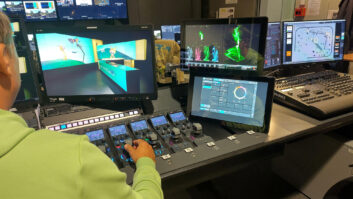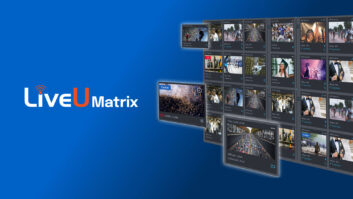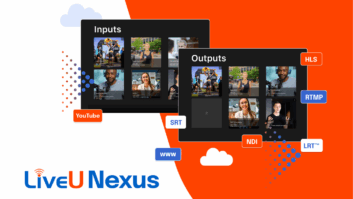
The broadcast arena is one well known for change – changing viewer behaviour, evolving technology and shifting business models. One of the most significant changes in the past few decades has been the move towards adopting IP as a standard infrastructure across the entire workflow, and making best use of it as a tool to move digital data from one point to the next. While it started off slowly, technology, expertise and attitudes have matured to such a degree that adoption of IP is today speeding up exponentially.
IP-based KVM technology is one of the most effective use cases in broadcasting for the benefits of this transport method. IP is being widely used in all areas of broadcast, from the outside broadcast truck and studio control room, to post production suites. Specifically, IP-based high performance KVM removes the limitations of traditional AV equipment and brings real-time, accurate video operation to these areas. Broadcasters are using switching and extension technology – not new by any means – to make operations leaner, more cost-effective and more flexible by basing it on standard IP network infrastructure.
The outside broadcast
An outside broadcast (OB) truck is, essentially, a mini-television studio on wheels, which is able to perform all the functions that a galley control room would. OB trucks are used mainly in broadcasting live events such as sports or news broadcasts, and function in much the same way as larger studio control rooms. They provide a confined, often pressurised environment that sees staff, including directors, technical directors, editors, operators, producers and audio engineers, performing a variety of tasks. These include monitoring video feeds, previewing shots, ensuring the quality of shots, guaranteeing the playback capabilities and transmitting the feed back to the studio or main truck that is controlling the broadcast.
The most important requirements for a smooth functioning OB truck are features such as instant video and USB switching capabilities, reliability, device support and ergonomics. There are a myriad of video and audio workflows coming into these trucks, and this content needs to be captured, recorded, edited and transmitted. KVM products enable staff to easily switch between and manage these streams from one location, giving operators the ability to control the equipment that perform these tasks. The IP infrastructure for the KVM means it is flexible enough to be easily, and instantaneously reconfigured, can integrate seamlessly with other systems and provides the resilience required to keep broadcasting.
Gallery control
From the OB truck to the gallery control room, IP-based KVM brings much improved levels of flexibility, scalability and comfort to the studio. While there may be more space than in an OB truck, it is still at a premium. The removal of the physical machines from the control room, and the additional heat and noise that is generated by them frees up space and adds comfort to the area.
The biggest requirement for the gallery control room is reliability. In a news bulletin, for example, the editor needs to be able to move effortlessly between shots and content to create a smooth flow between sections. IP infrastructure provides this reliability. The inherent, and instant flexibility of IP further allows a gallery to be re-configured at the touch of a button to manage different team profiles at different times of the day, or to switch from one production team to the next giving instant familiarity to the gallery environment.
Instant switching, as with the OB environment, is a major technical feature required in the gallery control room, as is the ability for a system to be able to cope with multiple types of devices. In this environment, touch screens are often incorporated into the system for ease of use and further elimination of the keyboard and mouse, high performance IP-based KVM manages these devices in its stride.
Post production
In the post production environment, IP-based KVM also yields significant benefits. Whether users are working on film, advertising or television content, the needs of a post suite remain the same. It is a completely different set-up from OB and gallery control, but the need for a quiet, comfortable working space with easy to use technology still underpins a successful environment. From an operator point of view KVM allows for the physical machines to be removed from the room and relocated to a central server room. Often this has benefits for the machines themselves – server rooms are kept secure and temperature controlled which adds to machine lifespan and performance. It also ensures that no unauthorised access is allowed, which may be an important consideration, especially for film and broadcast clients for whom piracy and the maintenance of intellectual property are key concerns.
KVM also works in this environment because it allows the creation of an edit suite based on specific customer requirements by enabling different clients to seamlessly switch between different resources. Editing suites can be easily configured with little effort, increasing the uptime of each room with no need for technical staff applying patches or making changes. This is especially advantageous when clients bring in their own machines to the studio, as they can be quickly taken to the server room and integrated with the KVM solution, negating the need for connections, cables and technical support. Once the editing suite is free, the client simply sits down; clicks a button and their content and software are displayed on the screen.
Apart from the requirement for a noise free workspace and the ability to share content, post production also focuses on two other areas of concern– pixel perfect video and accurate frame rate. When editing content, users must have absolute assurance that the picture on the screen is exactly the picture that was received from the camera and that the extension equipment has not altered or had any effect on the picture quality. Maintaining perfect colour space without introducing artefacts makes high performance IP-based KVM perfect for visual effects, grading and other image intensive applications.
Conclusion
There is little doubt that the future of broadcast is IP. What remains for broadcasters, both established organisations and new entrants, is to capitalise on the potential that IP brings to operations and fully realise its benefits — from cost saving and efficiency, to scalability and flexibility. And one of the best approaches to this is by looking at well-established technologies like high performance IP-based KVM to understand where that opportunity lies.
by Jamie Shepperd, group marketing manager, Adder Technology







